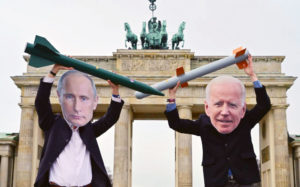As the Ukrainian army continues fighting to reclaim its territory, inch by inch, in brutal winter conditions, European leaders are scrambling to manage the continent’s diminished energy resources. Ukraine was once seen as the great hope on this front. The nation’s nuclear energy has been posited as a potential green power supply for a region overly reliant on Russia to meet its energy needs. Now, with Europe’s largest nuclear power plant under Russian control, the stability of nuclear alternatives and their potential to reduce Europe’s carbon footprint is marred by unbridled Russian aggression towards its neighbour.
Last week, Rishi Sunak and Joe Biden pledged to tackle energy price volatility through a new gas deal, known as the UK-US Energy Security and Affordability Partnership. The aim is to mitigate the fallout from Russia’s invasion of Ukraine, which caused international energy prices to surge, and put a disastrous amount of pressure on European consumers. The deal also promoted the use of nuclear energy as “a safe and reliable part of the clean energy transition” — which is ironic, given that one of the deal’s key beneficiaries, Germany, is in the process of closing its three remaining nuclear plants over safety concerns.
Ukraine has 15 nuclear reactors, which provide over half the country’s energy supply. This is convenient for the EU. Just last February, despite criticism from environmentalists, it classified nuclear energy as “green”. Ukraine joined the European Energy Community in 2010, intending to integrate into the European energy market, and in 2015 an ambitious agreement was signed between its Ukrenergo energy distribution company and Polenergia, a Polish counterpart, to export electricity to the EU as part of the Ukraine-Europe “energy bridge”. Despite a general distaste for nuclear energy in several EU countries, the move was seen as a good source of revenue for Ukraine and a move away from what was perceived as its dependence on Russian gas.
The integration, which had been planned for 2023, became urgent in February. Following the Russian invasion, Ukraine requested immediate synchronisation to the European power grid. (Ukrainian Energy Minister, Herman Galushchenko, pleaded with EU leaders, “I appeal to our European partners… We need your support and solidarity with the Ukrainian people more than ever!”) Russia, meanwhile, quickly took control of the power plant at Chernobyl.
Russian troops also pushed into Zaporizhzhya, home to the biggest power plant in Europe. It was here that, six years ago, the European Bank for Reconstruction and Development (EBRD) and the EIB coughed up one billion euros to support the construction of high-voltage transmission lines. But according to a government briefing document sent by those working in Ukraine’s nuclear sector, some people in the plant were working with Russia before the annexation of Zaporizhzhya. Seen exclusively by UnHerd, the briefing reads:
“There was a failed personnel policy, which over the past few years has concentrated the leadership — in key areas in the field — of people who are professionally and morally worthless, with dubious qualifications, unprofessional experience and without institutional memory, mostly citizens of the Russian Federation. They destroyed the system for documenting the managerial decision-making by closing access and classifying documents, which does not allow timely identification and correction of violations or bringing to responsibility for violations of nuclear legislation.”
Indeed, sources who were inside the plant told me that, when Russian authorities swept into Zaporizhzhya, some workers met them with the greeting, “welcome to your new Rosatom plant” — Rosatom being the Russian state nuclear corporation. Recent reports now allege that staff at the plant were “encouraged” to sign contracts with Rosatom.
There are also allegations that the management of Ukraine’s National Nuclear Energy Company, Energoatom, left the staff of Zaporizhzhya without support during the Russian invasion. Despite working in an industry that would obviously be targeted by Putin, no measures were taken to promote their safety, even though many stayed voluntarily to work in the plant, in an attempt to help the war effort. Allegations of corruption at Energoatom have been raised at a national level.
There has also been criticism of the International Atomic Energy Agency (IAEA), the world’s central intergovernmental organisation for nuclear power. Last March, it adopted Putin’s terms to refer to the invasion of Ukraine as a “special military operation in Ukraine”, infuriating some members of Ukraine’s political leadership, who accused it of placating Russia. In an interview with Politico in August, Galushchenko said the Russians had pushed the IAEA to visit the Zaporizhzhya plant, to see how well it was being managed, and to encourage the agency to accept Russian annexation of the plant.
As the invasion advanced, last spring, images of shelling in Zaporizhzhya found their way into Western media outlets. The international community looked on in horror at what could have been a nuclear Armageddon. Sources inside the plant described the consequences of a shell hitting the plant as potentially “far worse than Chernobyl or Fukushima”. And recent comments by President Vladimir Putin about Russian attacks on Ukraine’s energy infrastructure have once again stoked fears of nuclear disaster.
Speaking at an awards ceremony for “Heroes of Russia” at the Kremlin last week, he said: “Right now there has been a lot of noise about our attacks on the enemy infrastructure of the neighbouring country. Yes we are doing it.” He gave no indication that he intends to stop. Some in Ukraine’s energy sector are concerned that a “false flag” nuclear event could be staged in the country. In other words, Russia could fake a nuclear accident and then blame it on Ukraine.
Over in the West of the country, rumblings of a ground invasion from Belarus have been a cause for concern for those in Rivne. Industry insiders fear for the city’s nuclear plant, which provides energy to the major urban centres of Kyiv and Lviv. But Pavel Pavlishin, its former chief, said that, despite the bleak picture, it is unlikely that Russia will damage the plant even if they take control. “They developed this technology and they know how it works mainly.” One saving grace might be that the Ukrainian systems are significantly more advanced than the Russian — “We have made changes and upgraded our sites, they have not” — meaning it takes time for the invaders to understand.
A war is now being waged for the very Ukrainian plants that were supposed to be Europe’s ticket to a carbon-neutral future. Instead, they have become the stage for scenes from a horrifying sci-fi film. Last week, Ukrainian authorities accused Russian forces of installing multiple rocket launchers at Zaporizhzhya’s power plant. Could Europe’s largest nuclear plant be used to fire on Ukrainian troops?
It’s not out of the question that the plants could become weapons. Civilians fleeing the shelling in nearby regions have converged in the Zaporizhzhya area to access humanitarian aid. If the bombs get any closer, they could be caught in the crosshairs of a potentially unprecedented environmental catastrophe. Meanwhile, for workers in Europe’s biggest nuclear plant, the future is bleak. Some have, according to Energoatom, been taken by Russian authorities and “disappeared”. There’s no denying that Europe’s big plans for exporting green nuclear energy from Ukraine are now held, like much of the nation, in the hands of the Russian state.
Disclaimer
Some of the posts we share are controversial and we do not necessarily agree with them in the whole extend. Sometimes we agree with the content or part of it but we do not agree with the narration or language. Nevertheless we find them somehow interesting, valuable and/or informative or we share them, because we strongly believe in freedom of speech, free press and journalism. We strongly encourage you to have a critical approach to all the content, do your own research and analysis to build your own opinion.
We would be glad to have your feedback.
Source: UnHerd Read the original article here: https://unherd.com/



